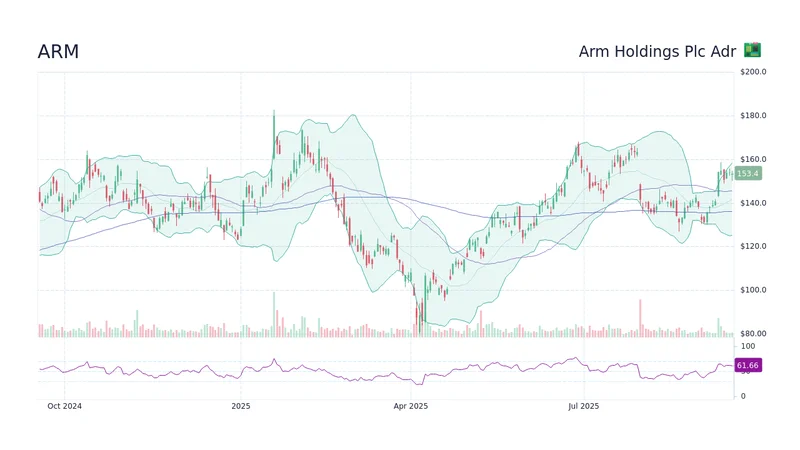ARM Stock: Analyzing the price surge and what comes next
ARM's Surge is a Warning Sign, Not a Victory Lap
On Monday, the market did what it does best: it reacted. Specifically, it sent shares of ARM Holdings up 11.1% on a tidal wave of volume. The trading desks lit up as 10.4 million shares changed hands—a 95% spike from the daily average. You can almost picture the flurry of activity, the frantic clicking of buy orders as the stock climbed to an intraday high of $175.
The official narrative, as seen in reports like ARM (NASDAQ:ARM) Shares Up 11.1% - Here's What Happened, is simple and seductive: “investor optimism regarding advancements in AI chips.” It’s a clean, compelling story. ARM is the architectural backbone of the mobile world, and now it’s poised to be the same for the AI revolution. The market, we are told, is simply waking up to this reality.
But a dispassionate look at the numbers tells a different, more complicated story. This surge feels less like a rational re-evaluation of a company’s fundamentals and more like a momentum trade catching fire. The optimism is real, but it’s running so far ahead of the data that it’s left the balance sheet in the dust. The question isn't whether ARM is a good company. The question is whether it's a $181 billion company with a price-to-earnings ratio of 260.
I've seen this pattern before. A powerful narrative takes hold, and the valuation becomes a secondary concern, sparking the inevitable question: ARM Stock Surge: Buy or Wait? But fundamentals, like gravity, always reassert themselves.
The Anatomy of a Fragile Rally
Let’s dissect the machinery behind this rally. The first place I look is the analyst consensus. On the surface, it’s a “Moderate Buy.” But peel back that label and you find a striking lack of conviction. Of the 27 analysts covering the stock, only one rates it a "Strong Buy." The rest are a scattered mix of eighteen "Buys," seven "Holds," and one outright "Sell." This is not the unified chorus you’d expect for a company supposedly on the cusp of AI dominance.
Even more telling are the recent adjustments. Morgan Stanley, while maintaining an "Overweight" rating, actually decreased its price target to $171 from $180. Goldman Sachs initiated coverage with a lukewarm "neutral" rating. These aren't the actions of firms seeing a sudden, unexpected catalyst. It suggests that while the long-term story is intact, the current valuation is giving even the bulls a moment of pause.
And this is the part of the analysis that I find genuinely puzzling. The market surged past these cautious price targets on the back of a vague sense of "optimism." What new information became available on Monday, October 13th, to justify such a move? Details remain conspicuously absent.

The real story is in the valuation. A P/E ratio of 260.52 is astronomical. It’s a number you might see in a pre-revenue biotech startup, not in a mature, profitable semiconductor designer. This valuation is like a skyscraper built on a single, slender pillar of future hope. It might stand for a while, but any unexpected tremor—a missed earnings target, a shift in the AI narrative—could bring the entire structure down. The company’s last reported quarterly EPS was $0.35, which was actually down from $0.40 in the same period a year prior. Revenue growth was solid, about 12%—to be more exact, 12.1% year-over-year. That’s healthy, but does it justify a valuation that demands perfection for the next decade?
Projecting Perfection and External Pressures
The bulls will point to November 5th, the date ARM is scheduled to announce its next quarterly results. The consensus forecast is for a 28% sales increase, fueled by licensing revenue and strong demand from key partners like Apple and the recent adoption by Qualcomm. This is where the entire bull case rests: on the flawless execution of future growth.
The market isn’t pricing in success; it’s pricing in a flawless victory. It has already baked in the 28% growth, the continued dominance in mobile, and a seamless pivot to rule the AI hardware space. If ARM reports 25% growth, which would be a phenomenal result for almost any other company, will the stock be rewarded? I suspect not. When expectations are this high, anything less than perfection is treated as a failure.
Then there's the external factor that few seem to be discussing: the SoftBank variable. ARM’s parent company is reportedly seeking a $5 billion margin loan, using its massive stake in ARM as collateral. This loan is intended to fund its own ambitious investments, potentially in OpenAI. This isn't just a financial footnote; it's a critical piece of the puzzle. It means SoftBank has a powerful, vested interest in maintaining not just a stable, but an elevated, share price for ARM.
This creates a synthetic pressure on the stock that has little to do with ARM’s own operational performance. How much of this recent rally is driven by investors who understand this dynamic? And what happens if the market turns and SoftBank faces the risk of a margin call on a loan of that magnitude (a loan reportedly worth $5 billion)? It introduces a systemic risk that is entirely external to ARM's business model but directly tied to its share price.
The Valuation is the Entire Story
Let’s be clear. The 11% jump on Monday wasn’t about a fundamental change in ARM’s business. No new revolutionary chip was announced. No blockbuster deal was signed. It was a sentiment-driven feedback loop in a stock already stretched to its absolute limit. The risk here isn't in ARM's technology—its architecture is brilliant and ubiquitous. The risk isn't in its business model, which is a cash-generating machine.
The risk is entirely in the price.
Investors on Monday weren't buying a stake in a company based on its present value. They were buying a lottery ticket on a very specific version of the future—one where ARM not only dominates AI but does so without a single misstep, justifying a valuation that defies conventional financial gravity. The price of that ticket is now 11% higher, and the odds haven't changed at all.
Related Articles
CRM Stock: Achmea's Increased Holdings and What It Means
A Glimpse Behind the Curtain: What Salesforce's Stock Activity Really Tells Us Achmea Investment Man...
PGE's Landmark Solar Investment: What It Means for Europe's Green Future
Why a Small Polish Solar Project is a Glimpse of Our Real Energy Future You probably scrolled right...
The VIX Name is a Complete Mess: What the Streaming Service Is vs. That Stock Market Thing
So, the market’s "fear gauge" finally decided to show a pulse. Give me a break. On Friday, the VIX s...
Comerica Bank: Locations, Phone Numbers, and Why You Can't Find a Human – Give Me a Break...
Generated Title: Comerica: Still a Bank, Or Just a Search Engine Optimization Nightmare? Okay, let's...
DWP Christmas Bonus 2025: Eligibility and Payment Shifts
The DWP's Christmas Bonus: A Tiny Spark of Hope in a Winter of Need Okay, folks, let's talk about so...
Rigetti Computing (RGTI) Secures $5.7M Quantum Order: Dissecting the Bull Case After its 9.6% Jump
Decoding Rigetti's Quantum Leap: Is a $5.7M Sale Worth a 25% Stock Pop? The news, when it hit the wi...





